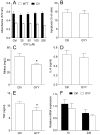The H₂S Donor GYY4137 Stimulates Reactive Oxygen Species Generation in BV2 Cells While Suppressing the Secretion of TNF and Nitric Oxide
- PMID: 30441775
- PMCID: PMC6278327
- DOI: 10.3390/molecules23112966
The H₂S Donor GYY4137 Stimulates Reactive Oxygen Species Generation in BV2 Cells While Suppressing the Secretion of TNF and Nitric Oxide
Abstract
GYY4137 is a hydrogen sulfide (H₂S) donor that has been shown to act in an anti-inflammatory manner in vitro and in vivo. Microglial cells are among the major players in immunoinflammatory, degenerative, and neoplastic disorders of the central nervous system, including multiple sclerosis, Parkinson's disease, Alzheimer's disease, and glioblastoma multiforme. So far, the effects of GYY4137 on microglial cells have not been thoroughly investigated. In this study, BV2 microglial cells were stimulated with interferon-gamma and lipopolysaccharide and treated with GYY4137. The agent did not influence the viability of BV2 cells in concentrations up to 200 μM. It inhibited tumor necrosis factor but not interleukin-6 production. Expression of CD40 and CD86 were reduced under the influence of the donor. The phagocytic ability of BV2 cells and nitric oxide production were also affected by the agent. Surprisingly, GYY4137 upregulated generation of reactive oxygen species (ROS) by BV2 cells. The effect was mimicked by another H₂S donor, Na₂S, and it was not reproduced in macrophages. Our results demonstrate that GYY4137 downregulates inflammatory properties of BV2 cells but increases their ability to generate ROS. Further investigation of this unexpected phenomenon is warranted.
Keywords: GYY4137; hydrogen sulfide; inflammation; microglia; reactive oxygen species.
Conflict of interest statement
The authors declare no conflict of interest.
Figures




Similar articles
-
H2S counteracts proinflammatory effects of LPS through modulation of multiple pathways in human cells.Inflamm Res. 2020 May;69(5):481-495. doi: 10.1007/s00011-020-01329-x. Epub 2020 Mar 11. Inflamm Res. 2020. PMID: 32157318
-
A synthetic diosgenin primary amine derivative attenuates LPS-stimulated inflammation via inhibition of NF-κB and JNK MAPK signaling in microglial BV2 cells.Int Immunopharmacol. 2018 Aug;61:204-214. doi: 10.1016/j.intimp.2018.05.021. Epub 2018 Jun 8. Int Immunopharmacol. 2018. PMID: 29890414
-
[Effects of the Hydrogen Sulfide Donor GYY4137 and HSP70 Protein on the Activation of SH-SY5Y Cells by Lipopolysaccharide].Mol Biol (Mosk). 2020 Nov-Dec;54(6):1018-1028. doi: 10.31857/S0026898420060142. Mol Biol (Mosk). 2020. PMID: 33276365 Russian.
-
Protective Smell of Hydrogen Sulfide and Polysulfide in Cisplatin-Induced Nephrotoxicity.Int J Mol Sci. 2019 Jan 14;20(2):313. doi: 10.3390/ijms20020313. Int J Mol Sci. 2019. PMID: 30646560 Free PMC article. Review.
-
Microglia--friend or foe.Front Biosci (Schol Ed). 2011 Jun 1;3(3):869-83. doi: 10.2741/193. Front Biosci (Schol Ed). 2011. PMID: 21622238 Review.
Cited by
-
Upregulation of Tolerogenic Pathways by the Hydrogen Sulfide Donor GYY4137 and Impaired Expression of H2S-Producing Enzymes in Multiple Sclerosis.Antioxidants (Basel). 2020 Jul 10;9(7):608. doi: 10.3390/antiox9070608. Antioxidants (Basel). 2020. PMID: 32664399 Free PMC article.
-
Current and Future Trends on Diagnosis and Prognosis of Glioblastoma: From Molecular Biology to Proteomics.Cells. 2019 Aug 9;8(8):863. doi: 10.3390/cells8080863. Cells. 2019. PMID: 31405017 Free PMC article. Review.
-
Novel AP39-Loaded Liposomes Sustain the Release of Hydrogen Sulphide, Enhance Blood-Brain Barrier Permeation, and Abrogate Oxidative Stress-Induced Mitochondrial Dysfunction in Brain Cells.Drug Des Devel Ther. 2025 Mar 19;19:2067-2079. doi: 10.2147/DDDT.S507697. eCollection 2025. Drug Des Devel Ther. 2025. PMID: 40124553 Free PMC article.
-
In Silico and In Vivo Analysis of IL37 in Multiple Sclerosis Reveals Its Probable Homeostatic Role on the Clinical Activity, Disability, and Treatment with Fingolimod.Molecules. 2019 Dec 19;25(1):20. doi: 10.3390/molecules25010020. Molecules. 2019. PMID: 31861585 Free PMC article.
-
Hydrogen Sulfide (H2S) Signaling as a Protective Mechanism against Endogenous and Exogenous Neurotoxicants.Curr Neuropharmacol. 2022;20(10):1908-1924. doi: 10.2174/1570159X20666220302101854. Curr Neuropharmacol. 2022. PMID: 35236265 Free PMC article. Review.
References
-
- Wallace J.L., Blackler R.W., Chan M.V., Da Silva G.J., Elsheikh W., Flannigan K.L., Gamaniek I., Manko A., Wang L., Motta J.-P., et al. Anti-inflammatory and cytoprotective actions of hydrogen sulfide: translation to therapeutics. Antioxid. Redox Signal. 2015;22:398–410. doi: 10.1089/ars.2014.5901. - DOI - PubMed
-
- Xue X., Bian J.-S. Neuroprotective effects of hydrogen sulfide in Parkinson’s disease animal models: methods and protocols. Methods Enzymol. 2015;554:169–186. - PubMed
MeSH terms
Substances
LinkOut - more resources
Full Text Sources
Research Materials

